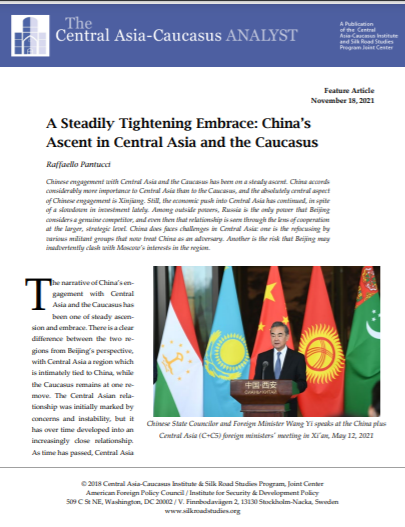A Steadily Tightening Embrace: China’s Ascent in Central Asia and the Caucasus
By: Raffaello Pantucci
 Chinese engagement with Central Asia and the Caucasus has been on a steady ascent.China accords considerably more importance to Central Asia than to the Caucasus, and theabsolutely central aspect of Chinese engagement is Xinjiang. Still, the economic push intoCentral Asia has continued, in spite of a slowdown in investment lately. Among outsidepowers, Russia is the only power that Beijing considers a genuine competitor, and even then that relationship is seen through the lens of cooperation at the larger, strategic level. China does faces challenges in Central Asia: one is the refocusing by various militant groups that now treat China as an adversary. Another is the risk that Beijing may inadvertently clash with Moscow’s interests in the region.
Chinese engagement with Central Asia and the Caucasus has been on a steady ascent.China accords considerably more importance to Central Asia than to the Caucasus, and theabsolutely central aspect of Chinese engagement is Xinjiang. Still, the economic push intoCentral Asia has continued, in spite of a slowdown in investment lately. Among outsidepowers, Russia is the only power that Beijing considers a genuine competitor, and even then that relationship is seen through the lens of cooperation at the larger, strategic level. China does faces challenges in Central Asia: one is the refocusing by various militant groups that now treat China as an adversary. Another is the risk that Beijing may inadvertently clash with Moscow’s interests in the region.
Over the past 30 years, the Japanese approach to Central Asia has been to secure the Japanese presence in the region by offering Central Asian nations an additional option of an international partner among traditional choices, such as Russia, and, in most recent history, China. The schemes offered to facilitate engagement between Japan and Central Asia were vibrant and diverse, reflecting the changing realities of the Central Asian region and the changing role and perception of the “self” in Japan. As is well documented in previous studies, the search for engagement schemes started with the 1996 Obuchi mission to Azerbaijan and Central Asia, spearheaded by the Member of Parliament and later Prime Minister Keizo Obuchi, which produced a strong endorsement of wider engagement of Japan in the region. It resulted in P.M. Ryutaro Hashimoto’s 1997 Eurasian/Silk Road Diplomacy speech, in which the concept of the Silk Road was first used as a geopolitical concept, embracing Central Asian states, China, Russia and Japan in an imagined net of interdependence. While the administrations of P.M. Obuchi (1998-1999) and P.M. Yoshirō Mori (1999-2000) did not proactively engage with the Central Asia region, it was P.M. Junichiro Koizumi’s administration (2001-2006) that aimed to aggressively shake up the Japanese approach to this region by announcing the Central Asia + Japan Dialogue Forum, a set of annual inter-ministerial and high-level talks to support Central Asian regional integration and to facilitate a larger corporate presence for Japanese corporate interests, in the face of growing Chinese and Russian pressures.
 Chinese engagement with Central Asia and the Caucasus has been on a steady ascent.China accords considerably more importance to Central Asia than to the Caucasus, and theabsolutely central aspect of Chinese engagement is Xinjiang. Still, the economic push intoCentral Asia has continued, in spite of a slowdown in investment lately. Among outsidepowers, Russia is the only power that Beijing considers a genuine competitor, and even then that relationship is seen through the lens of cooperation at the larger, strategic level. China does faces challenges in Central Asia: one is the refocusing by various militant groups that now treat China as an adversary. Another is the risk that Beijing may inadvertently clash with Moscow’s interests in the region.
Chinese engagement with Central Asia and the Caucasus has been on a steady ascent.China accords considerably more importance to Central Asia than to the Caucasus, and theabsolutely central aspect of Chinese engagement is Xinjiang. Still, the economic push intoCentral Asia has continued, in spite of a slowdown in investment lately. Among outsidepowers, Russia is the only power that Beijing considers a genuine competitor, and even then that relationship is seen through the lens of cooperation at the larger, strategic level. China does faces challenges in Central Asia: one is the refocusing by various militant groups that now treat China as an adversary. Another is the risk that Beijing may inadvertently clash with Moscow’s interests in the region.


